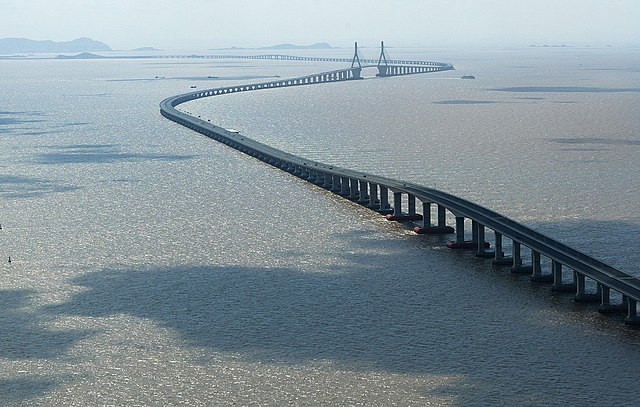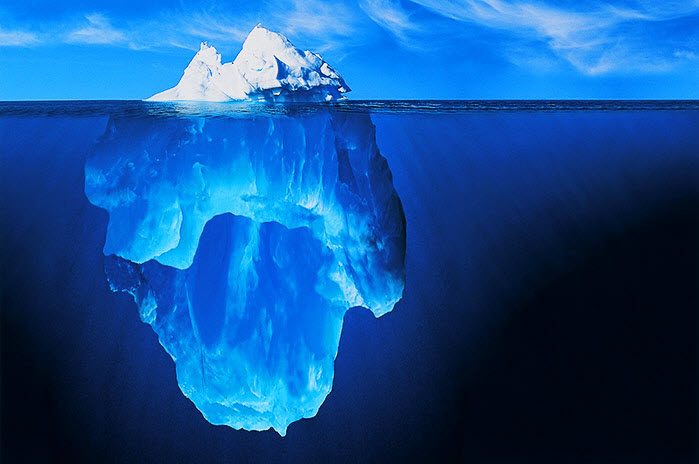Please use this technique. Counterarguments are not nearly as effective as
deconstructing the flat earth arguments.
I will now demolish this flimsy house of cards without one bit of math or science.

The bridge is indeed 102.4 miles. Correct.
However . . . It is a
viaduct, a bridge composed of several comparatively small
spans that can run
over both land and/or
water.
The
Danyang-Kunshan Grand Bridge in East China’s Jiangsu province does
both.
The Danyang-Kunshan Grand Bridge is a
rail line that runs parallel to the Yangtze River in the Yangtze River delta, passing through the northern edges of population centers and through the lowland region of rice paddies, canals, rivers, and lakes. It holds the Guinness World Record for the longest bridge on earth.
Of its 102.4 miles, a mere
5.6 mile section is actually
over open water, running across Yangcheng Lake in Suzhou.
The
Jiaozhou Bay Bridge, also known as Qungdoa Haiwan Bridge, in eastern China's Shandong province, is an
aggregated length of
25.84 miles long. It is the
world's longest bridge over water. However, only
16.1 miles of bridge are actually
over open water. It is frequently mistakenly confused with the water segment of Danyang-Kunshan Bridge in web sources. The two bridges are
unrelated.
Orbisect-64’s photo is of the
Donghai Bridge, a bridge connecting mainland Shanghai’s Pudong New Area with offshore Yangshan Port. It is considered one of the world’s longest bridges, with a total length of
20.2 miles. Most of the bridge is a low level
viaduct. To recap, that is a bridge composed of several comparatively small spans that can run over both land and/or water. This does
both. There are also some cable-stayed sections to this
automobile bridge. Of the bridge’s 20.2 mile length, about
15.7 miles run
over open water.
So, pictured with Orbisect-64’s
grandiose declarative statement is a portion of Donghai Bridge’s 15.7 mile long section, not the much smaller 5.6 mile long section of the Danyang-Kunshan rail bridge over Yangcheng Lake, which he should've pictured.
So, to recap:• Danyang-Kunshan Grand Bridge:
Guinness World Record holder at
102.4 miles total length;
5.6 mile section over open water.
• Jiaozhou Bay Bridge:
25.84 miles total length for world’s longest bridge over water;
16.1 miles actually over open water.
• Donghai Bridge:
20.2 miles total length; about
15.7 miles over open water.
My, how the numbers—and mountains—shrink.
What's the verdict?
Booyah! That was almost too easy, like shooting fish in a barrel. I Sherlock Holmes’d this one over coffee one morning after it was brought to my attention. Very poorly researched information that ignored crucial information in a hurry to jump to conclusions, thus overlooking its fatal flaws. The foundation is so badly laid that the subsequent math and argument are moot.
How about the
Lake Pontchartrain Causeway? Well, Lake Pontchartrain is an estuary in southeastern Louisiana in the southwestern United States. The Lake Pontchartrain Causeway is a bridge that holds the Guinness World Record for the
longest continuous bridge over open water at 23.79 miles. The bridge (actually a pair of bridges, side-by-side) is
remarkably straight over flat water. However, 24 miles on earth’s surface, regardless of sphere or plane, is virtually
negligible. But 8” drop per mile over 24 miles, you say. I agree, it looks good on paper. But is that all?
Let’s consider more of the facts. We haven’t factored in the
topography and
geography. A lake is a
basin, much like a
cavity or a
bowl, in which the
water is level. There are
lakebeds and
shores to remember, and these are rarely ever even. How about the bridges, and how their
locations and
design and
structure are very carefully planned by
engineers and
architects? And
construction crews follow those designs while frequently problem-solving and troubleshooting in the field. Bridges are built on rock
outcrops and
banks. In cases where the shoreline meeting the waterline is more flush, there are
platforms built to give them the height and leverage they need to span the expanse water effectively at each location. Accordingly, some bridges are straight and close to the water, others arch over the water. All of this is taken into consideration, however those decisions are more aesthetic and environmental because they're building the bridge over a
bowl filled with water, not over a
dome of water. Bridges consist of abutments, piers, pylons, pilings, stanchions, etc. If these appear to be of
uniform height from your view on the
surface of the water, remember that they’ll appear to be of different lengths
under the water. Different or same, they’re also driven
into the earth for stability, so there's more you can't see.
So much to consider, that’s what I’m saying. Don’t keep so fixed on the surface, but look below the surface, and then below that. The tendency to oversimplify things and dumb them down immensely is a trademark move in flat earth science.
Topography, geography, oceanography, geology, geophysics, ecology: to completely dismiss and ignore the earth sciences (geoscience) is to free your mind of logic and reason, surrendering and enslaving it to profound ignorance. You don't learn to think for yourself, you just learn to think incorrectly. You learn non sequitur science. By ignoring facts, you just learn to make errors and then compound them. I believe I've demonstrated this very effectively in the first section. I also recognize that flat earth science is doing this cumulatively with a growing body of flimsy evidence and that this is a faith-based movement. Unfortunately, I’ve been directed here by a flat earth preacher trying to convert me to the faith.
Now, for the
oceans, you can look at the
surface and discuss curvature, radius, flatness, planes, lighthouses, boats, adhesion, cohesion, surface tension, mirages, etc. Those all have their places in a much, much larger puzzle that forms the more complete picture (a composite picture, like earth from space; nothing’s ever as simple as it seems). You still haven’t looked below the surface: topography, geography, oceanography.
In your Puritanical rush to dismiss science and its accumulated body of knowledge as sorcery and witchcraft—and scientists as scions of Satan—in order to establish your own arguments to win debates, you ignore and miss tons of simpler facts and succumb to ignorance, then exclaim incredulously that people think you’re crazy when you bring up flat earth.
There’s a reason for that. There are tons of reasons for that. And the most evil villain of all? Not NASA. No, the incessant need to vilify Einstein is because with
gravity, the towers fall, collapsing in on their footprint, just like . . . And then, where did the debris go? Thus the superstitious witch hunts on Einstein and Newton, followed by NASA, Copernicus, Galileo, and the hit list goes on.
Look below the surface for the facts.
 Cognitive dissonance, confirmation bias, illusory superiority, delusions of grandeur . . . and let’s not forget the lies!! “People who support lies are liars.”—Orbisect-64
Cognitive dissonance, confirmation bias, illusory superiority, delusions of grandeur . . . and let’s not forget the lies!! “People who support lies are liars.”—Orbisect-64 Oh! What a tangled web we weave when first we practice to deceive." —Sir Walter Scott
Oh! What a tangled web we weave when first we practice to deceive." —Sir Walter Scott It is significant to note that Toby's "engineer" is his mom, a retired civil engineer with an Associate's Degree who worked for about 20 years for the DPW in a relatively small, rural town in New England. She had no experience with long bridges over open water and didn't bother to check the facts. That also helps us recalibrate. Toby's egregiously erroneous arguments were full of more holes than Swiss butter cheese. Not just one fact (he was only intelligent enough to notice one), but one fact after another.
Also, this kind of research can be done in only a couple of hours over coffee because it's really that
simple to pick apart all the errors in the flat earth rhetoric, especially when the competition isn't that smart. Thinking your smart and actually being smart are two entirely different things. And only researching flat earth "science" for a couple months, a couple weeks, or a couple hours doesn't really put me behind someone who's only been studying it for about a year. His genius and intellect is an illusion and I stand solidly behind my fact-checking skills.
Remember: Deconstruct and recalibrate.
Don't let his aggressive and abusive use of Bible verses phase you: he doesn't practice what he preaches.